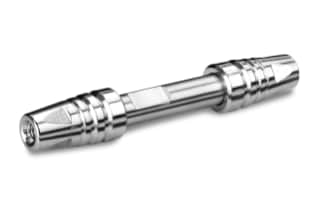
|
Chemistry |
C18 |
|
Separation Mode |
Reversed Phase |
|
Particle Substrate |
Hybrid |
|
pH Range Min |
1 pH |
|
pH Range Max |
12 pH |
|
Maximum Pressure |
10000 psi (690 Bar) |
|
Endcapped |
Yes |
|
Silanol Activity |
Low |
|
Particle Shape |
Spherical |
|
Particle Size |
2.5 µm |
|
Endfitting Type |
Parker-style |
|
Pore Size |
130 Å |
|
Format |
Column |
|
Surface Area |
185 |
|
System |
UHPLC, UPLC |
|
Particle Technology |
BEH |
|
USP Classification |
L1 |
|
Inner Diameter |
4.6 mm |
|
Length |
75 mm |
|
Carbon Load |
18 % |
|
UNSPSC |
41115709 |
|
Brand |
XBridge |
|
Product Type |
Columns |
|
Units per Package |
1 pk |
FAQs about the XBridge BEH C18 XP Column
In what way does the XBridge BEH C18 XP Column cater to the needs of high-sensitivity analyses?
The XBridge BEH C18 XP Column, with its sub-2-micron particle size, is designed for high-sensitivity analyses, providing excellent peak shapes and enhanced resolution for low-concentration analytes.
What benefits does the XBridge BEH C18 XP Column offer for method development?
The XBridge BEH C18 XP Column offers a wide pH stability range, making it a versatile choice for method development as it can operate effectively across various pH conditions, thereby accommodating a wide range of analytes.
Is the XBridge BEH C18 XP Column suitable for scaling up from analytical to preparative chromatography?
While the XBridge BEH C18 XP Column is primarily designed for analytical purposes, its robustness and reproducibility make it suitable for method development that can be scaled up, depending on the compatibility of the preparative system.
How does the XBridge BEH C18 XP Column handle complex biological samples?
The XBridge BEH C18 XP Column is capable of handling complex biological samples, offering strong retention and resolution for analytes even in the presence of matrix components, which is essential for bioanalytical assays.
What are the cleaning and regeneration protocols for the XBridge BEH C18 XP Column to ensure consistent performance?
The XBridge BEH C18 XP Column should be cleaned with appropriate solvent washes to remove any retained compounds and regenerated according to the manufacturer’s guidelines to maintain consistent performance and longevity.
What Is The Relationship Between Resolution, Efficiency, and Particle Size?
Resolution, efficiency, and particle size are closely linked in chromatography. Resolution is directly proportional to the square root of efficiency, while efficiency is inversely proportional to the particle size. This means, decreasing the particle size of the packing material results in increased separation efficiency. To achieve the gains of efficiency and resolution, the optimal flow rate must be run with respect to the particle size. The optimal flow rate [Fopt] is inversely proportional to the particle size. If the flow rate is increased, analytical run time and the width of the peak decreases. As peak width becomes narrower, the height of that peak increases proportionally. Narrower peaks that are taller, are easier to detect and differentiate from baseline noise [higher S/N], resulting in higher sensitivity.